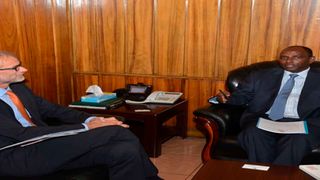
Treasury Cabinet Secretary Ukur Yatani with IMF representative to Kenya, Mr Jan Mikkelsen, at his office on August 08, 2019.
| Pool | Nation Media GroupBusiness
Premium
IMF reforms give Kenya window to shop for more loans
The International Monetary Fund (IMF) has relaxed its stringent lending policies, opening the doors for Kenya to take more loans to aid the fight against the Covid-19 pandemic.
The global lender approved new funding guidelines last week to better support the recovery of low-income countries from the deadly disease by giving them access to a larger pool of funds.
The IMF said relaxation of its rules will enable these cash-strapped nations to roll out much-needed intervention programmes to cushion their citizens from the pandemic.
It, however, reinforced safeguards to protect them from taking in more loans than they can handle, noting that high borrowing levels, even on concessional terms, could push them into a debt trap.
“The reforms approved by the IMF’s executive board seek to ensure that the Fund can flexibly support Low Income Countries (LICs’) financing needs during the pandemic and the recovery while continuing to provide concessional loans at zero interest rates,” the IMF said.
Concessional loans
The lender has increased the limit on access to concessional loans from its Poverty Reduction and Growth Trust (PRGT) by 45 per cent, which will give Kenya and other struggling countries the nod to acquire significantly larger amounts to plug their financing gaps.
Kenya’s Sh80 billion Rapid Credit Facility (RCF) loan in May last year was drawn from the PRGT, as well as the Extended Credit Facility (ECF) and Extended Fund Facility (EFF) from which it has already received Sh78 billion. This is part of the 38-month loan agreement signed in February worth Sh257 billion.
The IMF also announced that access to concessional financing will no longer be subject to maximum limits for poor countries that have put in place strong economic programmes that meet the criteria for obtaining above-normal access levels.
The mechanisms include implementation of drastic changes on expenditure and revenue collection as part of conditions the lender attaches to its loans in a bid to help the countries less reliant on external financing.
The lender has also retained zero interest rates for all loans drawn from the PRGT facilities, adding that interest rates, which are normally reviewed every two years, will be kept at zero until July 2023.
The IMF projects lending to poor countries during and in the aftermath of the pandemic to hit Sh5.2 trillion, and has rolled out a strategy to mobilise an additional Sh1.95 trillion into the PRGT and a further Sh358 billion in contributions from its member partners for lending at zero interest rates.
Policy reforms
“The centerpiece of the approved policy reforms is a 45 per cent increase in the normal limits on access to concessional financing, coupled with the elimination of hard limits on access for the poorest countries,” the IMF said.
“These higher access limits will allow provision of more concessional support to countries with large balance of payments needs that are implementing strong economic programs to restore inclusive growth, while maintaining sustainable debt positions.”
The reforms will be a relief to countries that are restricted from access to more loans due to the lender’s rigorous Debt Limits Policy (DLP).
This limits the amount of concessional loans they can take based on their ability to access alternative markets to shop for funds, and their ability to handle an additional debt to prevent them spiraling into debt distress.
The IMF projects Kenya to borrow Sh1.34 trillion between April this year and June next year made up of Sh517 billion of concessional debt, with the rest being a semi-concessional debt and an expensive commercial debt in a bid to plug a Sh952.9 billion budget deficit.
Kenya will use 40 per cent of this to service maturing debt, 35 per cent to build infrastructure projects, 19 per cent on budget financing, and just six per cent on social programmes meant to cushion vulnerable groups from the effects of the pandemic.
Kenya’s debt has hit a historic Sh7.71 trillion. A debt sustainability analysis published by the IMF in June stated that Kenya was among 29 low-income countries whose risk of failing to repay their debt was high, necessitating restructuring or bailout.
Poor states
The report says 24 of the 69 poor states are at moderate risk, nine have a low risk of debt distress, while seven – Zimbabwe, Sudan, Somalia, Sao Tome and Principe, Mozambique, Grenada and Congo Brazzaville – have already fallen into a debt quagmire.
The relaxed rules come as Kenya begins working on the drastic conditions that were attached on the last loan with as it seeks to increase revenue collection and cut state spending.
Key among the conditions is the mandatory restructuring of 18 State-owned enterprises that are accumulating huge levels of debt guaranteed by the exchequer. Many have spiraled into a web of losses, are technically insolvent and a constant drain on public resources as they depend on bailouts to remain afloat.
For instance, taxpayers have footed Sh6.9 billion of publicly guaranteed debt paid on behalf of the defunct City Council of Nairobi, Kenya Broadcasting Corporation, East African Portland Cement Company and Tana and Athi Rivers Development Authority between 2015 and last year.





